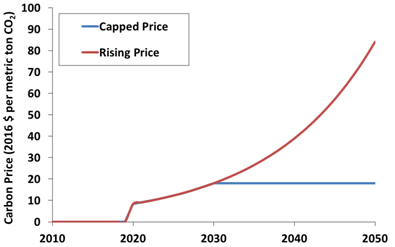Natural Gas: Role in Low Carbon Future
Frances Wood and Sharon Showalter at OnLocation co-authored a paper that was published in the latest issue of the journal Energy Policy. The publication, titled “Sensitivity of Natural Gas Deployment in the U.S. Power Sector to Future Carbon Policy Expectations,” describes results from a joint study with Dr. Bryan Mignone of ExxonMobil Research and Engineering Company, Haewon McJeon of the Pacific Northwest National Laboratory – Joint Global Change Research Institute, and Daniel Steinberg of the National Renewable Energy Laboratory. A presentation describing this study was also featured at the 2017 International Energy Workshop held at the University of Maryland College Park in July.
Efficient natural gas generation provides a relatively low cost path to reducing carbon emissions in the short run, but its role is less clear if large emission reductions are desired in the long run. The paper describes a modeling analysis that explores if and how the role of natural gas generation changes under a future with moderate and more stringent carbon reduction pathways.
Study Design
The study was performed using a customized version of the National Energy Modeling System (NEMS) created by OnLocation [1], and compares natural gas deployment in the U.S. power sector in two main scenarios:
- A capped carbon price scenario with resulting CO2 emissions similar to results from the EIA Annual Energy Outlook 2017 Reference Case with the Clean Power Plan;
- A rising carbon price scenario with a price that matches the capped price scenario through 2030 but that continues to rise at the same rate through 2050.

The key question is whether new gas capacity investments are significantly altered in the time period from 2020 to 2030 between the two scenarios based on the model’s foresight of future carbon prices and their impact on future operating costs for natural gas power plants.
Insightful Results
In both the capped and rising carbon price cases, natural gas played a significant role in achieving emissions reductions. Natural gas investment was virtually identical between the two scenarios, despite higher operating costs and lower utilization of these plants in later years in the rising price case. The results suggest that investment in new natural gas generation can be cost-effective even if future carbon reduction policies become more stringent in part because natural gas units have the ability to provide both energy and capacity services. The study concludes that natural gas can play a role in a transition to a low carbon future.
[1] All underlying model assumptions were adopted from the EIA Annual Energy Outlook 2017 reference case.

